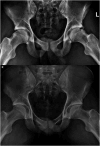Femoroacetabular Impingement: Critical Analysis Review of Current Nonoperative Treatments
- PMID: 40238927
- PMCID: PMC11939100
- DOI: 10.2106/JBJS.RVW.24.00211
Femoroacetabular Impingement: Critical Analysis Review of Current Nonoperative Treatments
Abstract
» Femoroacetabular impingement (FAI) is the premature contact of the femoral head-neck junction with the superior acetabular rim during hip range of motion, which may further damage intra-articular soft tissue structures and lead to the accelerated development of osteoarthritis.» FAI syndrome is diagnosed by a triad of symptoms, clinical signs, and imaging findings, and is a common cause of hip pain in young patients that have a significant impact on patient hip-related function and quality of life.» The treatment of FAI syndrome begins with noninvasive nonoperative modalities such as patient education and supervised exercise-based physical therapy. For recalcitrant symptoms, various injections have been explored for both diagnostic and therapeutic purposes; however, the efficacy of these interventions have generally not been demonstrated outside of the short term» In this article, we examine the available literature regarding the nonoperative treatment of FAI and provide insight into the effectiveness of current treatment modalities.
COPYRIGHT © 2025 BY THE JOURNAL OF BONE AND JOINT SURGERY, INCORPORATED.
Conflict of interest statement
Disclosure: The Disclosure of Potential Conflicts of Interest forms are provided with the online version of the article (http://links.lww.com/JBJSREV/B209).
Figures
Similar articles
-
Nonoperative Management of Femoroacetabular Impingement: A Prospective Study.Am J Sports Med. 2018 Dec;46(14):3415-3422. doi: 10.1177/0363546518804805. Epub 2018 Nov 6. Am J Sports Med. 2018. PMID: 30398893
-
Femoroacetabular impingement and osteoarthritis of the hip.Can Fam Physician. 2015 Dec;61(12):1055-60. Can Fam Physician. 2015. PMID: 26668284 Free PMC article.
-
Femoroacetabular Impingement Syndrome.Curr Sports Med Rep. 2020 Sep;19(9):360-366. doi: 10.1249/JSR.0000000000000748. Curr Sports Med Rep. 2020. PMID: 32925375 Review.
-
A multi-centre randomized controlled trial comparing arthroscopic osteochondroplasty and lavage with arthroscopic lavage alone on patient important outcomes and quality of life in the treatment of young adult (18-50) femoroacetabular impingement.BMC Musculoskelet Disord. 2015 Mar 20;16:64. doi: 10.1186/s12891-015-0500-y. BMC Musculoskelet Disord. 2015. PMID: 25886958 Free PMC article. Clinical Trial.
-
Femoroacetabular impingement - What the rheumatologist needs to know.Best Pract Res Clin Rheumatol. 2024 Mar;38(1):101932. doi: 10.1016/j.berh.2024.101932. Epub 2024 Feb 9. Best Pract Res Clin Rheumatol. 2024. PMID: 38336510 Review.
References
-
- Griffin DR, Dickenson EJ, O'Donnell J, Agricola R, Awan T, Beck M, Clohisy JC, Dijkstra HP, Falvey E, Gimpel M, Hinman RS, Hölmich P, Kassarjian A, Martin HD, Martin R, Mather RC, Philippon MJ, Reiman MP, Takla A, Thorborg K, Walker S, Weir A, Bennell KL. The Warwick Agreement on femoroacetabular impingement syndrome (FAI syndrome): an international consensus statement. Br J Sports Med. 2016;50(19):1169-76. - PubMed
-
- Ganz R, Parvizi J, Beck M, Leunig M, Nötzli H, Siebenrock KA. Femoroacetabular impingement: a cause for osteoarthritis of the hip. Clin Orthop Relat Res. 2003;417(417):112-20. - PubMed
-
- Trigg SD, Schroeder JD, Hulsopple C. Femoroacetabular impingement syndrome. Curr Sports Med Rep. 2020;19(9):360-6. - PubMed
-
- Khanna V, Caragianis A, Diprimio G, Rakhra K, Beaulé PE. Incidence of hip pain in a prospective cohort of asymptomatic volunteers: is the cam deformity a risk factor for hip pain? Am J Sports Med. 2014;42(4):793-7. - PubMed
-
- Frank JM, Harris JD, Erickson BJ, Slikker W, III, Bush-Joseph CA, Salata MJ, Nho SJ. Prevalence of femoroacetabular impingement imaging findings in asymptomatic volunteers: a systematic review. Arthroscopy. 2015;31(6):1199-204. - PubMed
Publication types
MeSH terms
LinkOut - more resources
Full Text Sources


